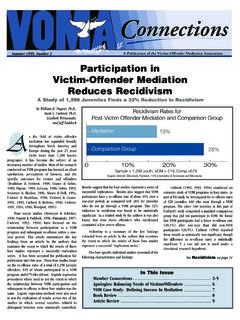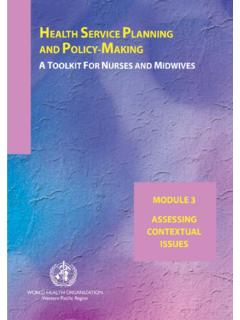Transcription of Domestic Violence and Restorative Justice: Advancing the ...
1 Domestic Violence and Restorative justice : Advancing the DialogueDomestic Violence and Restorative justice : Advancing the DialogueAlan Edwards and Jennifer HaslettInterest in Domestic Violence work has been growing for many years in the restorativejustice movement, particularly on an academic level. Resources and discussions thatconnected Restorative justice and Domestic Violence were very few five years ago, but thatis changing. Publications such as the collection Restorative justice and Family Violence (ed. by Strang and Braithwaite), the multi-year consultations between Restorative justiceadvocates, Domestic Violence workers and victims in the Canadian provinces ofSaskatchewan and Prince Edward Island, and the prevalence of Domestic violencediscussions at Restorative justice conferences, are all reflections of this movement sinterest in exploring what Restorative justice may have to offer, if anything, in cases ofdomestic , evidence of actual work in Restorative processes with victims of Domestic violenceand their offenders has been scarce.
2 Several possible scenarios may account for , most Restorative justice practitioners realize something of the seriousness and highrisks of working in this area, but perhaps lack the resources to properly addressthemselves to the task, and therefore do not accept Domestic Violence cases. Second,interested practitioners may be constrained by legal or other gatekeepers who see morerisk than benefit in opening the door to referring Domestic Violence cases to restorativejustice programs. Third, it is clear that some of the work that is going on in this area hascaused great harm (Busch, 2002; Coward, 2000) and this may cause some practitioners towant to close the door completely, understandably enough. Another scenario is thatinterested programs and practitioners may desire someone else s road map to use as aguide on their own journey into this Victim Offender Mediation (VOM) program of the Mediation and RestorativeJustice Centre (MRJC) in Edmonton, Alberta, Canada has been conducting restorativedialogue sessions with Domestic Violence victims and offenders since 1998.
3 We believethat sharing our experience may be beneficial to other interested practitioners, and mayhave discursive value, as Restorative justice practitioners interact with Domestic word about language usage in this paper may be beneficial. The overwhelmingmajority of our cases to date have involved female victims and male offenders, and ourgrounding in Domestic Violence theory and practice is consistent with this genderedimbalance. Certainly, we recognize (and have worked with) male victims and femaleoffenders and recognize the seriousness of those situations as well; still, in this paper,when we refer to victims , we mean female victims, and by offenders we mean maleoffenders. Second, most of our cases in MRJC s VOM program fall into the category offamily Violence , so when we refer to Domestic Violence , we are referring specifically tospousal or partner assault and whatever other abusive behaviours may be related to Violence and Restorative justice : Advancing the Dialogue2 Also, it is important for us to clarify the nature of the cases we have worked on.
4 When wehave brought together victims and offenders for Restorative dialogue sessions, it has beenin those cases where, after thorough screening and case development, we feel confidentthat: The victim s participation is well-informed and genuinely voluntary, The victim has the desire, strength, and feeling of safety to represent her ownneeds and talk honestly and in depth about her experience of his abusivebehaviours, and also feels safe terminating the sessions (thereby sending the caseback to court) if she is not hearing sufficient remorse or responsibility-taking fromher partner, The victim feels safe, physically and emotionally, outside of the sessions, and The offender is taking meaningful responsibility for his actions, is showingremorse, wants to be able to make different choices in any similar situations in thefuture, and is open to hearing about her experience of his actions and the impactsthose actions have had on PrioritiesRestorative justice as a framework for working with victims and offenders in theaftermath of crime has been adopted in a variety of processes and contexts over the many of the key components of this framework share basic commonalities.
5 Thevarious ways Restorative justice is practiced makes it important for each program toclearly articulate its priorities. Below are some of the central tenets informing therestorative justice approach we take in cases of Domestic Violence . These include a focuson harm, participant safety, offender accountability, opportunities for dialogue , justice begins with a focus on the harm inflicted and experienced byindividuals in the wake of crime. Often this harm is seen as resulting from a particularincident. An assumption of a single incidence of Violence within an intimate relationship,however, posits significant concern, given the pattern of abuse that so often exists inrelationships where Violence has been committed.
6 In cases involving Domestic Violence ,we believe exploring any history of abuse experienced in the relationship, and whetherthere is ongoing abuse, creates a deeper understanding of the nature and extent ofviolence in the relationship. A fuller understanding of the relationship in this regardprovides a context for assisting participants in identifying and exploring possible patternsof abuse and their impacts. This knowledge can be important in increasing awareness safety is a key concern in the practice of Restorative justice work. Given thatharm has already been experienced, we recognize the risk of further harm ensuing in adialogue about these painful experiences. We also recognize the reality that womenexperiencing Violence in intimate relationships are at increased risk of further Violence (Assessing Violence Against Women: A Statistical Profile 2002).
7 Maximizing safety inour work includes many steps throughout a Restorative process, the most important ofDomestic Violence and Restorative justice : Advancing the Dialogue3which is continuing to be in dialogue with the victim about her sense of safety. Once webetter understand her safety concerns, we can work with the victim and connect her withrelevant community resources to develop of an offender for his choices, actions and consequences of his actionscannot be overstated as a necessary component of the Restorative justice work we havedone in cases of Domestic Violence . The distinction between acknowledgement ofviolence occurring and responsibility for that Violence is significant. Responsibility goesfurther than acknowledgment in recognizing that the choices made to perpetrate violencewere wrong and should not have happened.
8 Without meaningful responsibility beingtaken by the offender for their harmful actions, a dialogue seriously risks causing furtherharm and is not likely to be conducive to positive changes in the offender s opportunities for those most impacted by harm to engage in dialogue about theviolence and the impacts that have resulted is also a consistent theme within restorativejustice philosophy. For victims of Domestic Violence , having a safe space to tell theirstory, be heard and validated can be a very powerful experience. For some victims,telling their story directly to the person who harmed them and having the opportunity toask questions and express emotions can be very meaningful, particularly when combinedwith hearing an offender take responsibility for his harmful actions.
9 As Kay Praniswrites, A very important value in Restorative justice is that of empowering unheardvoices. That is most often and most powerfully accomplished through personalnarratives. Listening respectfully to someone s story is a way of giving them power apositive kind of power. (Pranis, 2002). While the opportunity to participate in arestorative justice process may be an important step in any participants journey, it isimportant to keep in perspective that it is only one small point on a much larger and actions are also made prior and subsequent to any Restorative intervention,and these will all impact the dynamics of ongoing of the positive outcomes experienced through Restorative approaches have includedreconciliation, forgiveness, closure and restoration.
10 These outcomes can be veryimportant for participants, and are some of the healing experiences Restorative justiceseeks to foster in its work. The danger lies in creating any expectation or promise of theseoutcomes for participants. They are not outcomes to be manufactured in individuals,rather processes themselves that occur over time and are defined and unfold differentlyfor each person. Because there are no guarantees for how a dialogue may develop or whatunexpected emotions may arise, practitioners can only work with participants to identifytheir needs, reality check around their expectations and assist them in making aninformed decision about how to is important to note that the concept of restoration as it relates to our work in domesticviolence cases does not aim to restore individuals to a pre-assault state , the risk ofwhich could be effectively placing people back in circumstances that resulted in , as Llewellyn and Howse say, restoration can be described as the creation or re-creation of relationships of meaningful social equality (Llewellyn and Howse, 1999).













